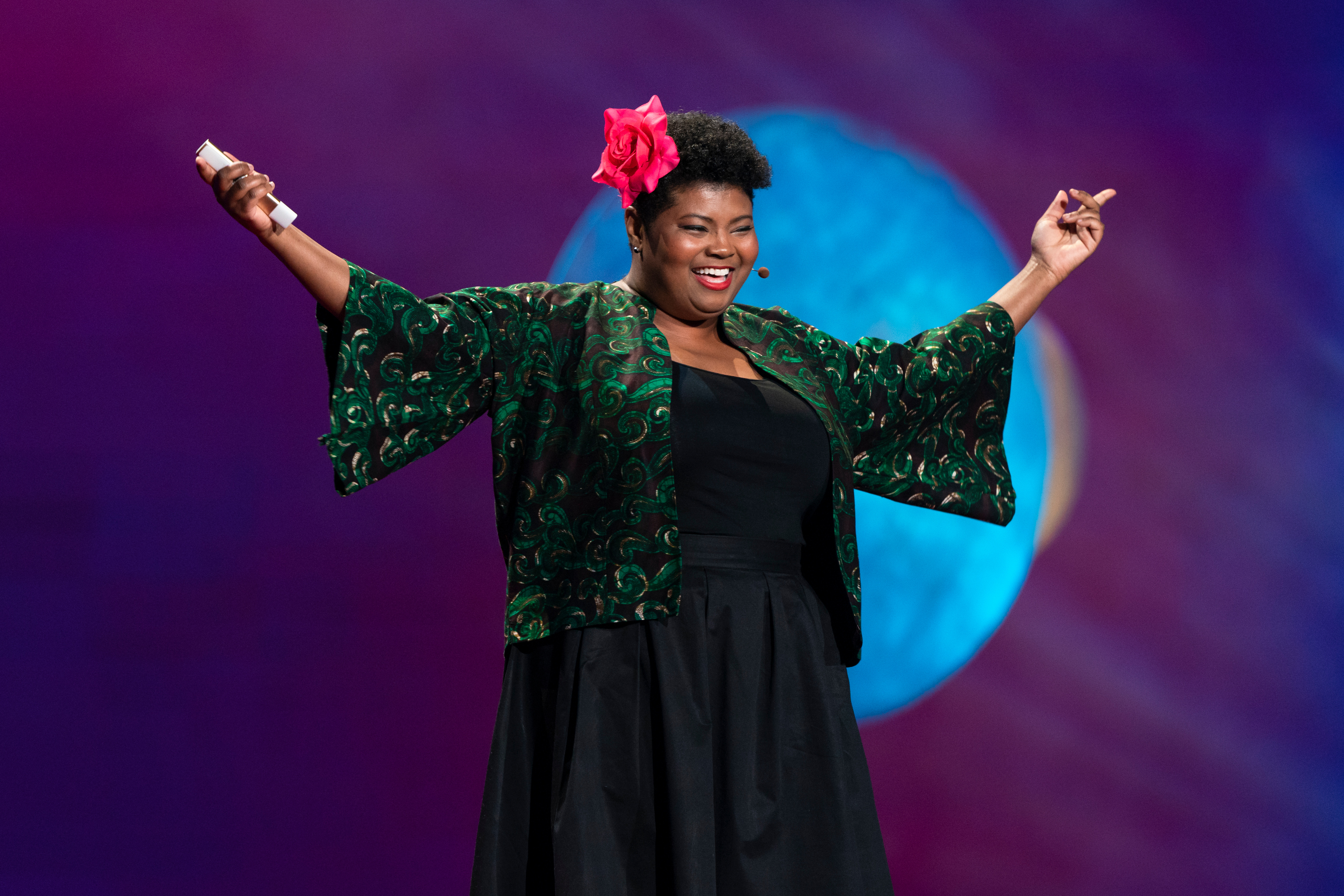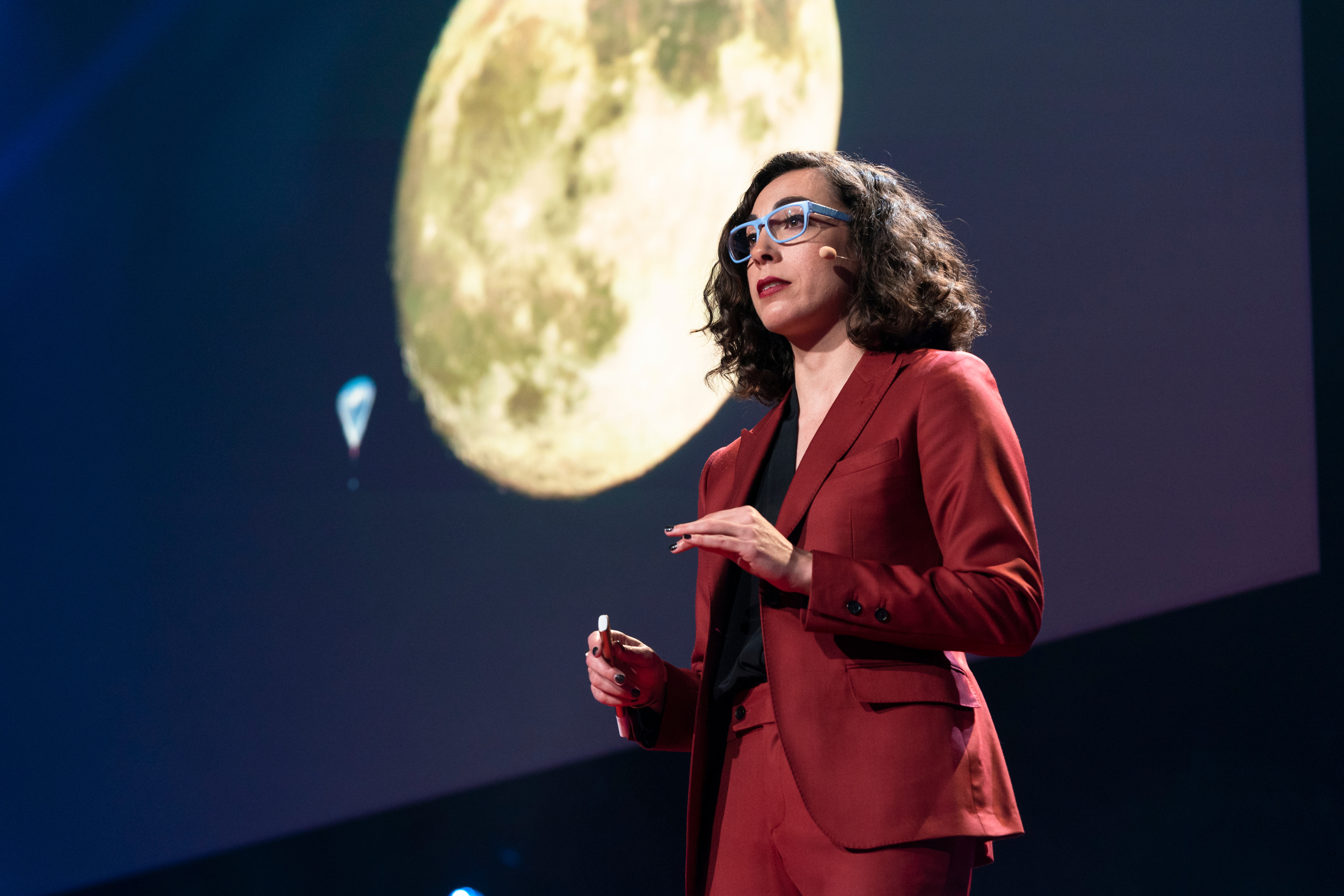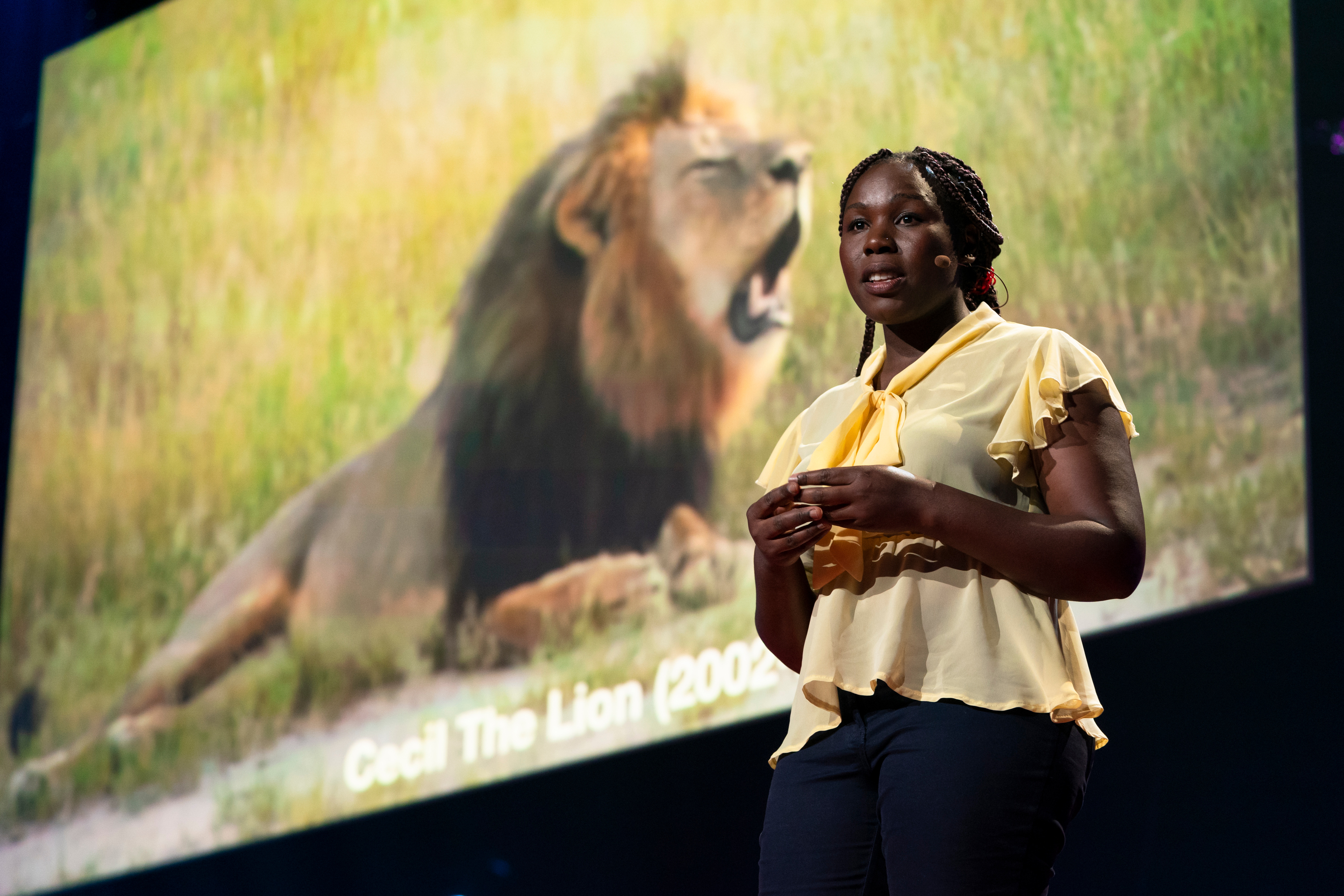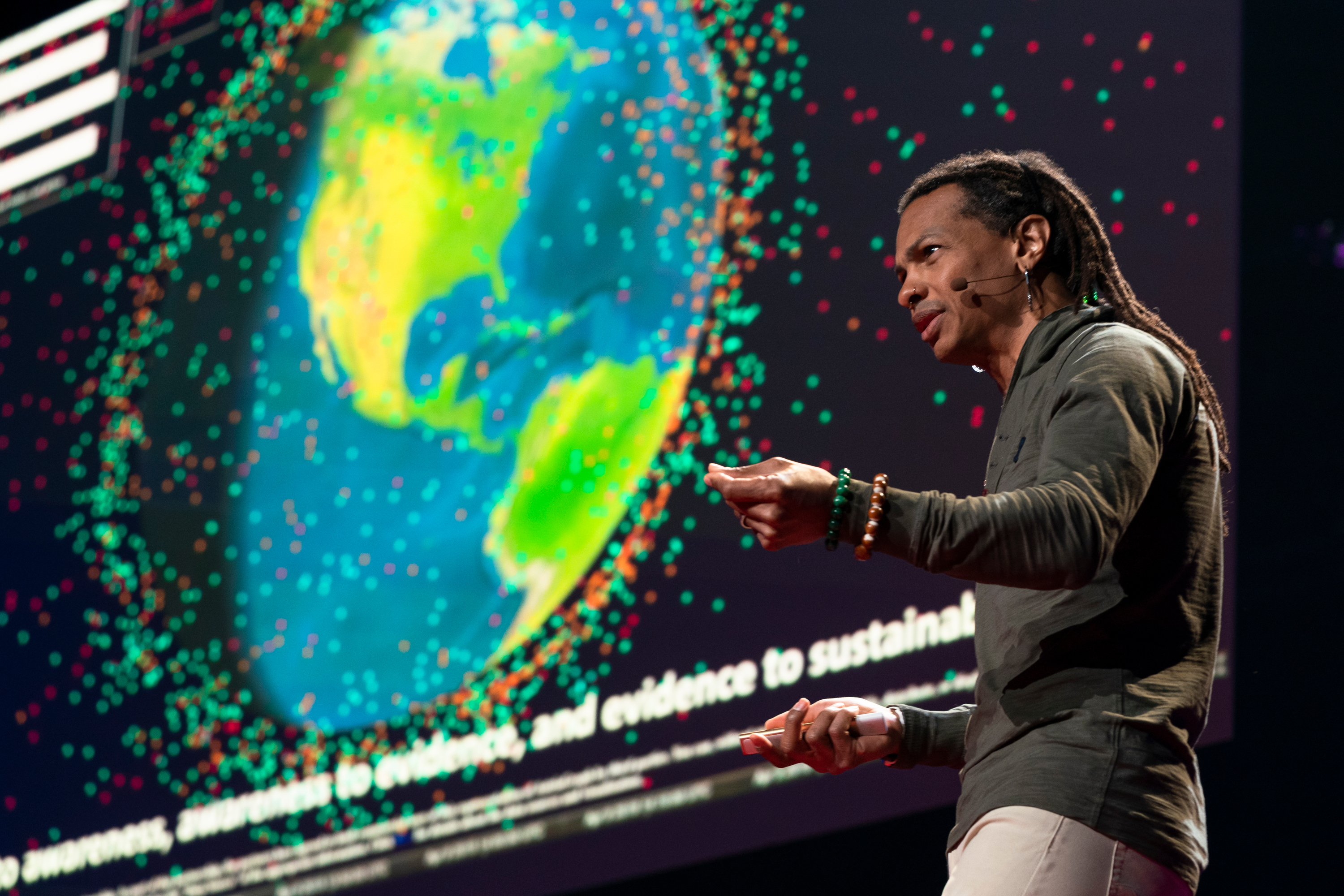
Biologist Danielle N. Lee teaches a memorable lesson on animal monogamy during TED Fellows Session 2 at TED2019: Bigger Than Us, on April 15, 2019 in Vancouver, BC, Canada. (Photo: Dian Lofton / TED)
The event: An afternoon session of talks and performances from TED Fellows, hosted by TED Fellows director Shoham Arad and TED Senior Fellow Jedidah Isler.
When and where: Monday, April 15, 2019, 2pm, at the Vancouver Convention Centre in Vancouver, BC.
The talks, in brief:
Erika Hamden, an astrophysicist who builds telescopes at the University of Arizona.
- Big idea: When we look at the universe we can see stars, but what we can’t see are most of the known atoms that form the universe. Learning more about those atoms, such as hydrogen, would go a long way in telling us how galaxies and stars are created, and how the universe evolved.
- How? Over the past 10 years, Hamden and her team have been building FIREBall, a UV telescope that can observe extremely faint light from huge clouds of hydrogen gas in and around galaxies. It hangs on a cable from a giant balloon from 130,000 feet in the stratosphere, at the very edge of space, for one night, to help observe these atoms.
- Quote of the talk: “I work on FIREBall because what I want to take our view of the universe from one of mostly darkness, with just light from stars, to one where we can see and measure nearly every atom that exists.”

Erika Hamden shows a view of the Moon next to, at lower left, a giant balloon carrying a space telescope she and her team designed. She speaks during TED Fellows Session 2 during TED2019: Bigger Than Us, on April 15, 2019 in Vancouver, BC, Canada. (Photo: Ryan Lash / TED)
Christopher Bahl, molecular engineer and protein designer.
- Big idea: New, exciting kinds of medicine made from very small and stable proteins, called constrained peptides, are nontoxic and highly potent for the treatment of disease. However, it’s expensive and time-consuming to reengineer constrained peptides found in nature to work as drugs.
- How? Bahl solves this problem by using computational design to build constrained peptides totally from scratch, using open source design software. The software can position individual atoms incredibly accurately, so that the peptide molecules are custom-tailored for drug development. So far, constrained peptides have been designed to safely neutralize influenza virus, protect against botulism poisoning and block cancer cells from growing.
- Quote of the talk: “Ultimately, I believe that designed peptide drugs will allow us to break free from the constraints of our diseases.”
Alexis Gambis, a filmmaker and biologist, as well as founder and executive director of film festival Imagine Science Films and creator of streaming film platform Labocine.
- Big idea: Storytelling through film can playfully help explain important scientific advancements and social issues, and science can be used as a lens through which to understand our own humanity.
- How? Gambis makes surreal, magical realist films grounded in real scientific fact while straddling experimental, documentary and fiction genres. Son of Monarchs tells a story of immigration and identity while incorporating current evolutionary biology research on the colors, patterns of a butterfly wing, climate justice and CRISPR. His heartfelt portrayal of scientists shifts stereotypes to make them more human and relatable.
- Quote of the talk: “We need more real science in fictional movies to create more eclectic, more inclusive, more poetic portrayals of science and scientists in the world.”
Hiromi Ozaki, an artist who explores the social and ethical implications of emerging technologies.
- Big idea: Recent developments in biotechnology and genetic engineering have made things possible that in the past we attributed only to gods and mythologies. Today, we have the knowledge of the pragmatics of science to create the magic of art.
- How? To create a real-life version of the Red String of Fate – string that binds romantic partners in an Asian lore – Ozaki worked with a geneticist to genetically engineer a silkworm with the DNA of a red glowing coral, adding the love hormone oxytocin. After rendering the mythical real, Ozaki brought it back into the realm of pop culture, making a bio-mythical film featuring an aspiring genetic engineer who creates the Red Silk to win the heart of her crush.
- Quote of the talk: “We managed to create something that we thought only existed in the world of mythology, through science.”
Muthoni Drummer Queen, musician and founder of two East African festivals: Blankets & Wine and Africa Nouveau.
- Big idea: Kenya is suffering from an identity crisis that, at its heart, has an attitude of exclusionism of otherness — a relic of its colonial past. It needs cultural spaces that celebrates and embraces its misfits.
- How? Muthoni Drummer Queen argues that Kenya’s creative industries have a huge role to play in building an inclusive, national pride. She points to examples in Kenyan film, radio, television music and fashion, as well as the music festivals she founded that have offered a platform to a diversity of talents and identities while creating a creative economy, and calls for more progress in these areas so that jobs can be created and Kenyan ideas exported world-wide.
- Quote of the talk: “We cannot build a nation unless we truly love it, and we cannot love it until we love ourselves.”

Conservationist Moreangels Mbizah worked with the famous Cecil the lion — until he was shot by a trophy hunter. How can we prevent the next tragedy? By enlisting locals to protect the species they coexist with. Mbizah speaks during TED Fellows Session 2 at TED2019: Bigger Than Us, on April 15, 2019 in Vancouver, BC, Canada. (Photo: Ryan Lash / TED)
Moreangels Mbizah, a lion conservationist and founder of Carnivore Conservation Zimbabwe.
- Big idea: Most conservationists working to protect wildlife in Zimbabwe are not from the countries or communities they serve. Yet the communities that live near this wildlife are the people best positioned to protect them.
- How? While local people grow up near wildlife, they often don’t come into contact with it unless they travel out to nature preserves. Mbizah suggests that conservationists should bring schoolchildren to national parks for a chance to connect with wildlife, while offering environmental education and teaching conservation skills. Most of all, conservation must include the economies of the people who share the land with wildlife. Locals play an important role in fighting poaching and illegal wildlife trade, so it’s important to embed conservation skills into these communities.
- Quote of the talk: “Sometimes change can only come when the people most affected and impacted take charge.”
Leila Pirhaji, a biotech entrepreneur and founder of ReviveMed, an AI-driven metabolomics platform focused on discovering drugs for metabolic diseases.
- Big idea: Many diseases, including fatty liver disease, are driven by metabolites – small molecules in our body like fat, glucose or cholesterol. To develop therapies that treat metabolic disorders, we need to study and understand metabolites, but identifying the vast numbers of metabolites in our bodies would require many experiments, which could take decades and billions of dollars.
- How? Pirhaji is developing an AI platform that can identify and understand a large set of metabolites from individual patients’ blood or tissues. It’s now working to develop treatments for diseases driven by metabolic dysregulation.
- Quote of the talk: “By collecting more and more data from metabolites and understanding how changes in metabolites lead to developing diseases, our algorithms will get smarter and smarter to discover the right therapeutics for the right patients.”

Moriba Jah shares a visualization of space junk during TED Fellows Session 2 at TED2019: Bigger Than Us, on April 15, 2019 in Vancouver, BC, Canada. (Photo: Ryan Lash / TED)
Moriba Jah, a space environmentalist and inventor of the orbital garbage monitoring software AstriaGraph.
- Big idea: We have a space garbage problem: Around half a million objects, some as small as a speck of paint, orbit the Earth and there’s no consensus on what’s in orbit or where.
- How? The ever-growing density of untracked flying debris poses a danger to the satellites and space vehicles being launched, yet we don’t yet have tools or policies to monitor and manage them. Jah’s AstriaGraph is an open and transparent database of space objects that aggregates multiple sources of space information. The database lets scientists quantify, assess and predict the behaviors of objects in space, to inform evidence-based space policy and decision-making.
- Quote of the talk: “In the absence of a framework to monitor activity in space, we risk losing the ability to use space for humanity’s benefit.”
Brandon Anderson, a data entrepreneur and inventor of the police-reporting platform Raheem.
- Big idea: People in the United States interact with police nearly 63 million times a year, but with 18,000 separate police departments in the US, those interactions aren’t methodically tracked — too often with tragic results. That needs to change.
- How? The majority of people who experience police violence, says Anderson, do not report it. So when he lost his life partner to police violence during a routine traffic stop, the former military engineer built Raheem, a platform that lets citizens log interactions with police, including the officer’s identity. During its pilot run in San Francisco, Raheem collected twice as many reports in three months as the city had collected in a year. This data is used by police oversight boards to write policies governing police performance, while public defenders use it as evidence against violent police officers.
- Quote of the talk: “We all deserve a world where we feel safe to live freely, a world where we feel safe to love freely. We are not only fighting for our right to live. We are fighting for our right to love.”
Skylar Tibbits, a designer, computational architect and founder of the Self-Assembly Lab at MIT
- Big idea: As we react to climate change, how can we adapt and build resilience? Perhaps by studying natural materials that assemble themselves and adapt to their environment.
- How? Tibbits’ lab was asked to weigh in on this question: Could self-assembly be used to tackle sea level rise in the fragile islands of the Maldives, where climate change is causing land loss? As they watched the motion of the waves and the topography of the reef cause natural sandbars to form, Tibbits and his colleagues realized they could use these natural forces to build sandbars where they’re needed, by assembling underwater forms that work with the tides to pick up the sand where it can accumulate. Think of it as a movable, adaptable reef.
- Quote of the talk: “It’s a different model for climate change: One that’s about adaptation and resilience rather than resistance and fear.”
Danielle N. Lee, a behavioral biologist, educator and STEM advocate.
- Big idea: Lee uses hip hop to communicate science concepts and terms to audiences that popular science often overlooks.
- How? Take “O.P.P.” by Naughty By Nature, released in 1991 – a song whose lyrics about monogamy (or lack of it) perfectly mirror an evolutionary biology discovery of around the same time: that songbirds – once thought to be strictly monogamous – engaged in what’s politely called Extra Pair Copulation. “You down with EPC? / Yeah, you know me!”
- Quote of the talk: “Hip hop song references are a really good tool for teaching concepts to students from hip hop culture or urban communities. I use it intentionally, tapping into vocabulary they already know and systems they already comprehend. In the process is it ratifies them – us, our culture – as knowledge purveyors.”
Andrew Nemr, tap dancer and dance oral historian, artistic director of the Vancouver Tap Dance Society
- Big idea: The audio aspect of the craft of tap dance is just as essential as the visual.
- How? Dancing us into TED2019, Nemr and ensemble perform a choose-your-own-adventure dance, inviting audience members to close their eyes and open them throughout the piece, as they feel led.
- Quote of the talk: “I want the audience to experience the form without the visual component, so that they can understand that the music-making part of tap dance is equally important.”